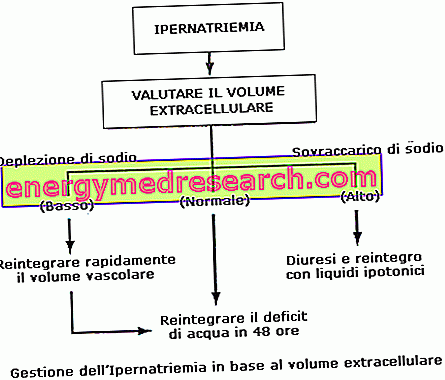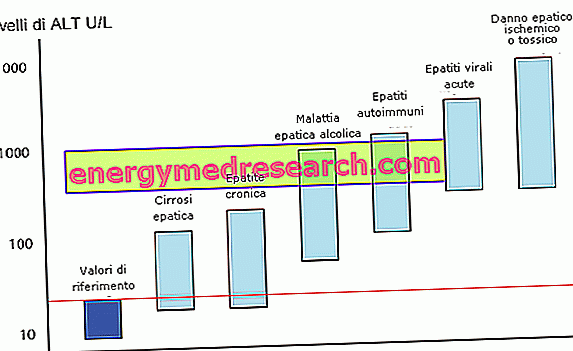Signs and symptoms
The main and most precocious symptom of hypernatremia is intense thirst ; if this is not perceived or is not satisfied signs of suffering of the central nervous system appear:
- Lethargy
- Irritability
- Mental confusion
- Seizure crisis
- Coma
accompanied by spasticity, hyperreflexia, nausea and vomiting. Nervous symptoms are due to dehydration of the brain cells, which transfer water to the hyper-osmotic extracellular compartment. For this reason, vascular ruptures with cerebral hemorrhage or subarachnoid hemorrhage may also appear. The signs and symptoms of hypernatremia are all the more evident the higher the serum sodium concentration and the faster the disorder is established. The rapid increase in plasma sodium concentration, without the brain having the possibility of adapting to it, often leads to permanent neurological damage.
In children, hypernatremia can give rise to hyperpnea, muscle weakness, restlessness, insomnia, lethargy and crying with sharp cries. A further progression of hypersiemia, especially during hypernatriemic dehydration, leads the small patient to lethargy, convulsions and coma.
The acute onset of hypersiememia increases mortality, as well as advanced age is another unfavorable prognostic element. The mortality rate is high for natriemia values above 180 mEq / L in acute forms, particularly in adults; this rate is 40% higher in children and about 75% in adults.
The chronic form of hypernatremia is somewhat less severe and has a lower mortality. Within 1-3 days of the onset of hypernatremia, the brain is in fact able to implement a series of compensatory mechanisms to increase the osmolarity of the intracellular environment: it increases the synthesis of osmotically active substances and reduces their excretion. In this way the osmotic gradient decreases and with it the loss of intracellular water is reduced.
These adaptations are of great importance from a therapeutic point of view.
Treatment
- Hypovolemic hypernatremia: correction of the volume deficit by the administration of hypotonic saline solutions (or isotonic in the case of severe hypovolemia symptoms) until the symptoms of hypovolemia are improved; Removal of the cause. Then the water deficiency * is corrected with hypotonic sodium chloride solution at 0.45% or 5% glucose solution.
- Euvolemic hypernatriemia: correction of water deficiency * with hypotonic sodium chloride solution at 0.45% or 5% glucose solution, carefully checking sodium for avoiding water intoxication. In central or neurogenic diabetes insipidus the administration of Vasopressin is necessary; in nephrogenic diabetes insipidus administer diuretics and limit the sodium intake with the diet (see drugs for the treatment of diabetes insipidus)
- Hypervolemic hypernatremia: excess sodium must be removed using diuretics (furosemide) associated with reintegration with hypotonic liquids; if hypernatremia is refractory to treatment, dialysis is used

* Free Water Deficiency = TBW x [(natriemia / 140) -1]
where TBW = total body water estimated multiplying by 0.6 the weight in kg of the patient or by 0.4 its lean mass
Approximately half of the free water deficit should be covered over the first 24 hours and the second half over the next 24-48 hours. A more rapid and aggressive correction is recommended only in the case of acute hypernatremia
For clinical purposes, then, it is very important to determine whether the form is acute or chronic:
- acute hypernatremia: onset less than 24 hours, with or without neuropsychic manifestations. It should be corrected within 24 hours: reduce sodium by about 1-2 mEq / l per hour
- chronic hypernatremia: days have passed since the onset of hypersiemia; in this case the phenomena of hyperosmotic adaptation of brain cells have already been completed; this requires a slower correction of vascular volume and water deficit (within 48-72 hours instead of 24), in order to avoid the appearance of cerebral edema, with coma, convulsions and death. To avoid this occurrence it is necessary to lower the sodium concentration to no more than 0.5 mEq / l per hour



